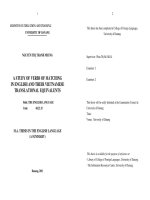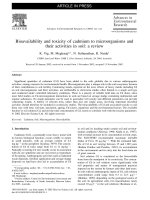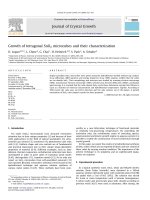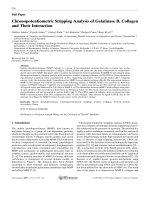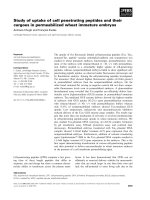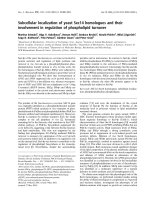Theoretical investigations of sandwich molecular clusters and nanowires, and their surface assembly
Bạn đang xem bản rút gọn của tài liệu. Xem và tải ngay bản đầy đủ của tài liệu tại đây (2.97 MB, 114 trang )
THEORETICAL INVESTIGATIONS OF SANDWICH MOLECULAR
CLUSTERS AND NANOWIRES, AND THEIR SURFACE ASSEMBLY
TAN WEE BOON
(B. Sci. (Hons)), NUS
A THESIS SUBMITTED FOR THE DEGREE OF
DOCTOR OF PHILOSOPHY
DEPARTMENT OF CHEMISTRY
NATIONAL UNIVERSITY OF SINGAPORE
2013
Acknowledgements
During my four and a half years of graduate study at National University of Singapore, I
have benefited and learnt tremendously from my supervisors, fellow colleagues, collaborators as
well as my family members.
First of all, I would like to offer my sincere and utmost gratitude to my supervisor, Prof.
Xu Guo Qin, for providing me this wonderful opportunity to work under him for my graduate
study. I am very appreciative and thankful for his guidance, invaluable advices and patience over
the last four years. The discussions I have engaged with him are always enriching and mind-
invoking. Once again, I thank you for the priceless mentoring for the past four years.
Secondly, I would like to offer my heartfelt appreciation towards my co-supervisor, Dr
Yang Shuo-Wang, for his patient guidance, support and encouragement in my research. You
provided me the opportunity to make the transition from surface science to computational
chemistry, and enable me to complete the project with minimal difficulties.
To my colleagues, namely Shao Yanxia, Wang Shuai, He Jinghui, Dong Dong, Mao Wei,
Dr Zhang Yongping, Chen Zhangxian and Li Wanchao as well as Wu Jianchun and Wang Qiang
whom are my seniors in IHPC, I would like to thank all of you for your invaluable assistance and
discussions during the past four years. It has been a heartwarming experience working with all of
you.
Lastly and most importantly, I want to thank my parents, my spouse, my daughter, and all
other family members. I would not be receiving this degree without your limitless love, care and
concern, and continuous support and encouragement.
The financial support was provided by Department of Chemistry, National University of
Singapore. Computational resources and the relevant technical assistance were provided by the
Institute of High Performance Computing (IHPC) under the Agency for Science, Technology
and Research (A*STAR) throughout the four and a half years of my graduate study.
I
Table of Contents
Acknowledgements
Table of Contents
I
Summary
III
List of Tables
V
List of Figures
VI
List of Symbols
VIII
Chapter 1 Introduction
1
1.1 Experimental accomplishments of multidecker sandwich complexes and clusters
3
1.1.1 Multidecker sandwich complexes and clusters containing pure hydrocarbon rings
3
1.1.2 Multidecker sandwich complexes and clusters containing boron- and silicon-
substituted heterocycles
4
1.2 Theoretical investigations on multidecker sandwich complexes, clusters and SMWs
6
1.3 Studies of adsorption of SMCs and SMWs on substrates
9
1.4 Objectives and scope of this thesis
10
1.5 References
12
Chapter 2 Theoretical Background and Calculation Methodology
21
2.1 Ab initio calculations
21
2.2 Density Functional Theory
22
2.2.1 Hohenberg and Kohn theorem
23
2.2.2 Kohn and Sham Equation
24
2.3 Exchange-correlation functional approximations
25
2.3.1 Local Density Approximation
25
2.3.2 General Gradient Approximation
27
2.4 Calculations methods employed in this thesis
27
2.5 References
29
Chapter 3 Boratabenzene-Vanadium Sandwich Molecular Wire and its properties
32
3.1 Computational details
33
3.2 Structure and properties of V
n
(HBBz)
n+1
clusters
34
II
3.3 Structure and properties of (HBBz-V)
∞
SMW
47
3.4 Conclusion
51
3.5 References
51
Chapter 4 Silacyclopentadiene-Metal Multidecker Sandwich Molecular Wires
54
4.1 Computational details
55
4.2 V
n
(
Si
Cp)
n+1
and Fe
n
(
Si
Cp)
n+1
sandwich molecular clusters
56
4.3 (
Si
Cp-M)
∞
sandwich molecular wires
63
4.4 Germacyclopentadienyl sandwich molecular clusters and infinite nanowires
69
4.5 Conclusion
73
4.6 References
73
Chapter 5 Silacyclopentadienyl-Transition Metal Multidecker Sandwich Molecular
Wires on H-passivated Si(100) surface
76
5.1 Computational details
77
5.2 Adsorption of (
Si
Cp-V)
∞
SMW on Si(100)-H surface
78
5.3 Adsorption of (
Si
Cp-Mn)
∞
SMW on Si(100)-H surface
83
5.4 Conclusion
88
5.5 References
89
Chapter 6 Summary and Future Research
90
6.1 Summary
90
6.2 Proposed future studies
92
6.2.1 Search for novel boratabenzene/boratacyclooctatetraene SMWs
92
6.2.2 Assembly of related SMWs onto silicon substrates
93
6.3 References
93
APPENDIX A
APPENDIX B
95
99
APPENDIX C
APPENDIX D
101
102
III
Summary
Theoretical Investigations of sandwich molecular clusters and nanowires, and
their surface assembly
Tan Wee Boon
National University of Singapore
2013
The present dissertation reports on theoretical investigations of transition metal multidecker
sandwich molecular clusters (SMCs) and their corresponding one-dimensional infinite
nanowires. The current theoretical studies on one-dimensional infinite sandwich molecular wires
(SMWs) predict interesting electronic and magnetic properties that can be found in these SMWs.
Examples include half metallicity, high spin filter efficiency, negative differential resistance
effects and the ability to function as magnetic on/off molecular switches. In the current work, the
structural, electronic and magnetic properties of vanadium boratabenzene SMW are studied
theoretically. The vanadium boratabenzene SMW is predicted to be a ferromagnetic conductive
nanowire and the vanadium atoms couple ferromagnetically throughout the SMW via the
superexchange coupling mechanism. Subsequently, SMWs containing silacyclopentadienyl ring
ligands with four transition metals from the 3d series are explored. Theoretical findings reveal a
trend of switching from being a conductive wire to a half metallic one, and finally to become a
semiconducting wire as the transition metal atoms are varied with increasing atomic number
(from vanadium to iron). Finally, assembly of two silacyclopentadienyl type of SMWs are
investigated on a semiconducting hydrogen passivated Si(100) surface. Selective rows of
IV
dangling bonds can be exposed via feedback-controlled lithography. The vanadium
silacyclopentadienyl SMW retains its metallic feature after the assembly, while the manganese
silacyclopentadienyl SMW changes from being a semiconductor to quasi metallic. The surface
silicon atoms that are chemically bonded to the silacyclopentadienyl ligands experience electron
charge transfer from the transition metal atoms, while the bulk silicon substrate remains
chemically unaffected after the assembly of the SMWs. The theoretical work conducted in this
thesis offer vast potential opportunities in the design of novel nanowires for future spintronic and
nanoelectronic applications.
V
List of Tables
Table 3.1 Structural and magnetic properties of V
n
(HBBz)
n+1
clusters (n = 1 – 5)
and (HBBz-V)
∞
infinite SMW.
35
Table 3.2 Structural and magnetic properties of TM(HBBz)
2
(TM = Fe, Mn, Cr).
36
Table 3.3 Spin assignment and local magnetic moments of V
n
(HBBz)
n+1
clusters
(n = 1 – 5) clusters.
42
Table 3.4 Structural, electronic and magnetic properties of (HBBz-V)
∞
infinite
SMW in different conformations.
46
Table 4.1 Spin assignment and local magnetic moments of V
n
(
Si
Cp)
n+1
clusters
(n = 1 – 4) clusters.
61
Table 4.2 Structural, electronic and magnetic properties of (
Si
Cp-TM)
∞
(TM = V,
Cr, Mn, Fe) infinite SMWs in different conformations.
63
Table 4.3 Spin assignment and local magnetic moments of V
n
(
Ge
Cp)
n+1
clusters
(n = 1 – 3) clusters.
71
VI
List of Figures
Figure 1.1 Synthesis of the first triple-decker sandwich compound, [(
5
-
C
5
H
5
)
3
Ni
2
]
+
.
4
Figure 1.2 Synthesis of the iron complex sandwiched by two
germacyclopentadienyl ligands, [
5
-C
4
Me
4
GeSi(SiMe
3
)
3
]
2
Fe.
5
Figure 1.3 Structural models for infinite (Cp-V)
∞
, (Bz-V)
∞
and (Pn-V)
∞
SMWs.
7
Figure 3.1 (a) Structure optimization model for the (HBBz-V)
∞
wire with the
boron atoms arranged in a transoid manner(neighboring B atoms rotated 180
o
).
(b) Total energies of the (HBBz-V)
∞
wire at the different conformations.
34
Figure 3.2 Optimized structures showing different conformations of
V
n
(HBBz)
(n+1)
(n = 1 - 5). Selected bond distances are indicated in the figures.
38
Figure 3.3 Optimized structures showing different conformations of
TM(HBBz)
2
(TM = Fe, Mn, Cr). Selected bond distances are indicated in the
figures.
39
Figure 3.4 Molecular orbital diagram of the 180
o
conformer of V
3
(HBBz)
4
.
40
Figure 3.5 Iso-surfaces of electron charge density difference for the transoid
conformer of (VHBBz)
∞
.
44
Figure 3.6 Spin density diagrams of the V(HBBz)
2
, 120
o
and 180
o
conformers of
V
2
(HBBz)
3
.
45
Figure 3.7 Spin polarized band structure of (HBBz-V)
∞
for the transoid
conformer.
49
Figure 4.1 Structural model for an infinite SMW with eclipsed conformation.
56
Figure 4.2 Optimized structures showing different conformations of Fe
n
(
Si
Cp)
n+1
(n = 1 - 4).
57
Figure 4.3 Optimized structures showing different conformations of V
n
(
Si
Cp)
n+1
(n = 1 - 4).
58
Figure 4.4 Optimized structure of the eclipsed conformer of the Fe(
Si
Cp)
2
molecule with selected bond lengths indicated.
59
VII
Figure 4.5 Optimized structure of the 144
o
conformer of the V(
Si
Cp)
2
molecule
with selected bond lengths indicated.
60
Figure 4.6 Band structures indicating the spin up (left) and spin channels (right)
of (a) (
Si
Cp-V)
∞
, (b) (
Si
Cp-Cr)
∞
, (c) (
Si
Cp-Mn)
∞
and (d) (
Si
Cp-Fe)
∞
, respectively.
65
Figure 4.7 Iso-surfaces of electron charge density difference for the eclipsed
conformer of (
Si
Cp-M)
∞
.
67
Figure 4.8 Iso-surfaces of electron charge density difference for the eclipsed
conformer of (a) (Cp-V)
∞
(Ref. 17) and (b) (
Si
Cp-V)
∞
, respectively.
68
Figure 4.9 Optimized structures showing different conformations of M
n
(
Ge
Cp)
n+1
(M = Fe, V, n = 1 - 3).
71
Figure 5.1 (a) A side view and (b) front view of (
Cp
Si-M)
∞
(M = V, Mn)
absorbed on H-Si(100) along the [100] direction.
78
Figure 5.2 Band structure indicating the spin up (left) and spin down channels
(right) of (
Si
Cp-V)
∞
along [001] direction on H-Si(100) surface.
79
Figure 5.3 3p projected DOS (pDOS) and the total DOS of the silicon atoms in
Si
Cp and on the surface, respectively.
81/82
Figure 5.4 DOS and local magnetic moments (in parentheses) of vanadium
atoms in (
Si
Cp-V)
∞
SMW on the Si(100)-H surface.
82
Figure 5.5 Iso-surfaces of electron charge density difference for (
Si
Cp-V)
∞
on
Si(100)-H.
83
Figure 5.6 Band structure indicating the spin up (left) and spin down channels
(right) of (
Si
Cp-Mn)
∞
on Si(100)-H surface.
84
Figure 5.7 3p projected DOS (pDOS) and the total DOS of the silicon atoms in
Si
Cp and on the surface, respectively.
85
Figure 5.8 DOS and local magnetic moments (in parentheses) of manganese
atoms in (
Si
Cp-Mn)
∞
SMW on the Si(100)-H surface.
86
Figure 5.9 Iso-surfaces of electron charge density difference for (
Si
Cp-Mn)
∞
on
Si(100)-H.
86
Figure A4.1 Calculated highest occupied molecular orbitals (HOMO) and
lowest unoccupied molecular orbitals (LUMO) for Fe
n
(
X
Cp)
n+1
(X = C, Si, Ge, n
= 1 - 3).
101
VIII
List of Symbols
Å Angstrom
AFM Antiferromagnetic
Ant Anthracene
BBz Borabenzene
Bz Benzene
COT Cyclooctatetraenyl
Cp Cyclopentadienyl
Cp* Pentamethylcyclopentadienyl
DFT Density Functional Theory
DNP Double Numerical plus Polarization
DOS Density of States
eV electron Volt
FiM Ferrimagnetic
FM Ferromagnetic
Ge
Cp Germacyclopentadienyl
GGA Generalized Gradient Approximation
HBBz Boratabenzene
HF Hartree-Fock
HK Hohenberg and Kohn
HREELS High Resolution Electron Energy Loss Spectroscopy
KS Kohn and Sham
LDA Local Density Approximation
IX
LMM Local Magnetic Moment
Me Methyl
Np Naphthalene
PAW Projector Augmented Wave
PBE Perdew-Burke-Ernzenhof
Pen Pentacene
Pn Pentalene
PW91 Perdew-Wang 91
SAM Self-Assembled Monolayer
SCF Self-Consistent Field
Si
Cp Silacyclopentadienyl
SMC Sandwich Molecular Cluster
SMW Sandwich Molecular Wire
STM Scanning Tunneling Microscopy
TM Transition Metal
VASP Vienna ab initio Simulation Package
XC Exchange-Correlation
1
Chapter 1
Introduction
Molecular wires are the fundamental building blocks for molecular electronic devices.
The most common types of molecular nanowires are based on organic molecules due to their
ease of chemical modification and high flexibility during processing. Oligomers or polymers,
1-4
despite with desired properties, usually do not possess suitable functional groups which allow
them to bind to substrates. On the other hand, structures having such functional groups that
facilitate strong surface adsorption typically exhibit poor electrical conductivity, as charge
carriers tend to localize at these functional groups. Another class of molecular wires is the metal
nanowires, which exhibit high electrical conductivity due to high charge carrier concentrations;
however one major challenge associated with the application of these nanowires is the effect of
electromigration,
5,6
which causes the eventual breakage of the nanowires.
In recent years, there has been increasing dedication to sandwich compounds as a novel
class of molecular wires. Sandwich compounds are typical compounds featuring a metal atom
positioned and bound by haptic covalent bonds in between two arene ligands, which include the
metallocences. Since the first report on the synthesis of ferrocene, [(C
5
H
5
)
2
Fe], by Pauson and
Kealy in 1951
7
and the structure characterization by Woodward and Wilkinson later in 1952,
8
the
field of organometallic sandwich compounds has developed tremendously. The ever-growing
interest in these complexes stems from their wide-reaching relevance to catalysis, novel
magnetic materials and optical materials, polymers, molecular recognition and medical
applications.
9
In particular, multidecker sandwich compounds have been generating keen interest
2
and attention ever since the isolation and characterization of the first triple-decker sandwich
compound featuring cyclopentadienyl ligands in 1972 by Werner and Salzer.
10,11
Subsequent
vigorous research activities resulted in the isolation and structural characterization of a large
variety of transition metal triple-decker and multidecker complexes. The ring ligands acting as
bridging units in the formation of multidecker sandwich complexes ranges from arenes,
12
anionic
phospholyl ligands,
13
boroles,
14
and boratabenzenes,
15
as well as purely inorganic ring systems
such as boranes,
16
carboranes,
17,18
P
5
and P
6
.
19-24
Among these multidecker complexes, interesting magnetic properties have been found in
vanadium-benzene multidecker clusters, V
n
Bz
(n+1)
. The vanadium-benzene multidecker sandwich
clusters display ferromagnetism
25,26
and possess magnetic moments that increase linearly with
increasing vanadium atoms.
27,28
Theoretical studies on the infinite one dimensional vanadium-
benzene wire, (V-Bz)
∞
, further reveal that the infinite wire is a half metallic ferromagnet, and it
is predicted to be 100% spin polarized.
29,30
Meanwhile, the infinite form of vanadocene, (V-
Cp)
∞
, is also theoretically predicted to be a half metallic ferromagnet,
31
while (Fe-Cp)
∞
32
and
(Fe-Cp*)
∞
33
display negative differential resistance property and high spin-filter efficiency.
However, the hydrocarbon ring ligands in these sandwich molecular wires (SMWs) are
chemically inert which results in difficulty for the SMWs to assemble on surfaces. The present
thesis focuses on the theoretical investigation of structural, electronic and magnetic properties of
SMWs with selected boron and silicon substituted heterocycles as ring ligands. By substituting
with selected heterocycles, it is hoped that better insight and alternatives on anchoring the SMWs
on surfaces stably can be achieved, while hoping to retain the desirable properties displayed by
the standalone SMWs. Eventually, the knowledge may help researchers to realize the mass
3
assembly of these SMWs onto surfaces and become promising materials for future application in
molecular electronics and spintronics.
1.1 Experimental accomplishments of multidecker sandwich complexes and clusters
1.1.1 Multidecker sandwich complexes and clusters containing pure hydrocarbon rings
The first triple-decker sandwich compound was synthesized in 1972 upon heating
nickelocene with HBF
4
in propionic anhydride and analyzed as the cation [(
5
-C
5
H
5
)
3
Ni
2
]
+
(Figure 1.1).
10,11
A year later Schilderout reported the detection of [(
5
-C
5
H
5
)
3
Fe
2
]
+
in mass
spectroscopic studies of gaseous ferrocene.
34
An alternate route to producing triple-decker
sandwich compounds can be realized by treating electron rich metallocenes such as Cp*
2
M (M=
Ru, Os) with electrophilic reagents, eg. [CpRu(NCMe)
3
]
+
.
35
Synthesis of bimetallic
permethylpentalene complexes, Pn*
2
M
2
(M = V, Cr, Mn, Co, Ni; Pn* = C
8
(Me)
6
), has been
accomplished and structurally characterized by Ashley et al. in the solid state by single-crystal
X-ray diffraction.
36
Meanwhile, the larger 10π-aromatic cyclooctatetraenyl anion (C
8
H
8
2-
or
COT
2-
) is more suited for multidecker sandwich compounds containing rare earth and actinide
elements, with the first compound of such type, Ce
2
(COT)
3
, was produced by Cesca et al.
37
and
the development of related compounds containing the f-elements is described by Edelmann in a
recent review.
38
4
Figure 1.1 Synthesis of the first triple-decker sandwich compound, [(
5
-C
5
H
5
)
3
Ni
2
]
+
.
1.1.2 Multidecker sandwich complexes and clusters containing boron- and silicon-
substituted heterocycles
In the past fifteen years, organometallic complexes can be efficiently synthesized as
multidecker sandwich clusters in molecular beams via gas-phase reactions of laser-vaporized
metal atoms with organic ligands. In this technique a laser beam vaporizes the target metal, and
the ensuing hot plume of metal atoms is cooled in an inert gas environments seeded with the
appropriate organic molecules. Examples of multidecker sandwich complexes that are produced
via this method include V
n
(Bz)
n+1
(n = 1 - 4)
25, 39-43
and Sc
n
(Bz)
n+1
(n = 1 - 2),
25
and rare earth
metal clusters Ln
n
(COT)
n+1
(Ln = Ce, Nd, Eu, Ho and Yb)
44,45
where an 18-layer one
dimensional Eu
n
(COT)
n+1
was successfully synthesized and is the longest multidecker sandwich
molecular wire to date.
46
The only experimentally known bimetallic multidecker sandwich
cluster, V
n
(FeCp
2
)
n+1
(n = 1 – 3), was also synthesized by laser vaporization of vanadium atoms
and ferrocene targets.
47
5
The development of the chemistry of transition metal sandwich compounds containing
boron substituted heterocyclic ring ligands started with Herberich’s 1970 report of the synthesis
of a cobalt-bound boratabenzene
48
and Ashe’s 1971 description of the synthesis of lithium 1-
phenylboratabenzene.
49
Since then a wide variety of transition metal compounds of
boratabenzene had been synthesized by Herberich and co-workers
50-54
as well as Ashe and co-
workers.
55-58
Meanwhile, the first reported triple-deck sandwich complexes containing
boratabenzene as bridging ligand have been prepared through the reaction of Cp*Ru(C
5
H
5
B-Me)
with metallo-electrophiles, and the structure has been established by X-ray crystallography.
51,52
Furthermore, efficient new methods of the synthesis of boratabenzene salts have been developed,
thereby making them readily accessible.
59-63
Sandwich compounds featuring another class of heterocycles, the heavy cyclopentadienyl
ligand, was first reported by Tilley et al. by the reaction of lithium germacyclopentadienide
Li[Me
4
C
4
Ge-Si(SiMe
3
)
3
] with [{(Me
5
C
5
)Ru(μ-Cl)}
4
].
64
Subsequently, other TM complexes (Zr,
Hf, Ru, Rh, Ir) with either sila- or germacyclopentadienyl ligands were prepared by the same
research group.
65-69
In addition, an iron complex in which two germacyclopentadienyl ligands
sandwiched the central iron atom was prepared, where the germanium atoms are rotated away
72
o
from each other due to the presence of bulky substituents at the germanium atom (Figure
1.2).
70
Figure 1.2 Synthesis of the iron complex sandwiched by two germacyclopentadienyl ligands,
[
5
-C
4
Me
4
GeSi(SiMe
3
)
3
]
2
Fe.
6
In summary, the experimental accomplishments for transition metal multidecker
transition metal complexes covered in this section provide concrete support to the experimental
feasibility of the multidecker sandwich clusters and the infinite sandwich nanowires that are
studied in this thesis.
1.2 Theoretical investigations on multidecker sandwich complexes, clusters and SMWs
The early theoretical investigations on sandwich metallocences focused mainly on the
structural and magnetic properties of the sandwich complexes.
71-78
Since the experimental
suggestion of ferromagnetism in multidecker V
n
Bz
m
complexes, many theoretical studies have
been performed which shed light on the structural, electronic and magnetic properties of
multidecker transition metal and rare earth metal sandwich multidecker molecular complexes
and infinite one-dimensional SMWs. Among the earlier reports, Maslyuk et al. have predicted
(Bz-V)
∞
SMW (Figure 1.3) to be a half metallic ferromagnet,
29
with a spin-polarized band
structure with a finite density of states at the Fermi level for one spin channel and a
semiconductor gap for the other, affording half metallic character which was previously only
observed in Heusler alloys,
79,80
metal oxides
81-83
and sulfides.
84
Interestingly, Zhou et al
theoretically predicted that (Cp-Fe)
∞
possess three unique properties simultaneously, having half
metallicity, high spin filter effects and negative differential resistance.
32
Furthermore, the
mechanism behind the half metallicity and ferromagnetism in the first row transition metal (Cp-
TM)
∞
was unveiled by Shen et al. and was found to be completely different from that observed
in (Bz-TM)
∞
.
31
The formation of (Cp-TM)
∞
SMWs was revealed to have occurred through the
transfer of one valence electron from the transition metal to the cyclopentadienyl ring, forming
an alternating arrangement of Cp
-
and TM
+
structures. In contrast, the interactions in (Bz-TM)
∞
7
SMWs are mainly covalent as benzene is already in an aromatic electronic configuration and no
electron transfer would be observed.
31
Large magnetic moments were observed in europium
cyclooctatetraene multidecker clusters, Eu
n
(COT)
n+1
(n = 1 - 4),
85
and increase linearly with
increasing europium atoms, and while the SMW is a FM semiconductor, it displays nearly 100%
spin filter efficiency.
86
Borazine (B
3
N
3
H
6
), widely regarded inorganic analog to benzene, was
also explored as a potential ring ligand in the formation of SMWs. Mallajosyula et al. reported
efficient spin filter properties and half metallic character in (Borazine-V)
∞
87
, and the electronic
and magnetic properties of the early first row (Borazine-TM)
∞
SMWs are similar to (Bz-TM)
∞
SMWs.
88
Figure 1.3 Structural models for infinite (Cp-V)
∞
, (Bz-V)
∞
and (Pn-V)
∞
SMWs, respectively.
Grey atoms denote carbon atoms, white atoms denote hydrogen atoms and dark green spheres
denote the vanadium atoms, respectively.
8
In addition to monometallic SMWs, considerable theoretical studies have been devoted to
hybrid bimetallic SMWs and SMWs containing two or three fused rings as ring ligands, which
reveal further interesting properties. The performance of spin filter efficiency has been
demonstrated to be tunable in the bimetallic (CpFeCpV)
n
wire
89
, which can also function as a
half metallic spintronic switch under a controlled external electrical field
90
or through
customized redox reactions.
91
Meanwhile, the (CpFeCpV)
∞
SMW was determined to be a FM
semiconductor
92
and is also known to exhibit magnetic moment enhancement with respect to the
monometallic SMWs, (Cp-V)
∞
(Figure 1.3) and (Cp-Fe)
∞
.
93
SMWs that include fused rings such
as pentalene, naphthalene, anthracene and pentacene are also theoretically well studied. The
pentalene and pentacene analogues for vanadium, (Pn-V
2
)
∞
(Figure 1.3) and (Pen-V
n
)
∞
(n = 3 or
4) respectively, are known to exhibit excellent thermodynamic stability,
94,95
while the
naphthalene analog, (Np-V
2
)
∞
, is switchable between AFM and FM states by injection of
electrons
96
or holes
96,97
into the SMW. Half metallic behavior is predicted to be observed in the
vanadium anthracene SMW, (Ant-V
2
)
∞
.
98
Overall, transition metal multidecker SMCs and their corresponding one dimensional
infinite SMWs exhibit intriguing and fascinating electronic and magnetic properties. All of the
aforementioned theoretical studies involve ring ligands that are pure hydrocarbons which are
formed from strong C-C bonds within the cyclic skeleton and inert C-H bonds surrounding the
rings. Though the SMWs are robust and display high thermodynamic stability, it remains a
daunting task for these SMWs to assemble stably on templates for practical applications.
9
1.3 Studies of adsorption of SMCs and SMWs on substrates
There has been a longstanding interest in patterning metallocenes and their infinite
SMWs on surfaces. A STM-assisted dissociative adsorption of ferrocene has been proposed as a
method for patterning substrates for carbon nanotube growth.
99
The adsorption of ferrocene on
graphite was investigated by Durston and Palmer using high resolution electron energy loss
spectroscopy (HREELS) where the ferrocene molecules are physisorbed with the its five-fold
symmetric molecular axis oriented approximately perpendicular to the surface.
100
Mitsui et al.
had reported the deposition of vanadium-benzene sandwich clusters on n-alkanethiolate self-
assembled monolayer (SAM) coated gold substrates under ultrahigh vacuum conditions.
101
The
non-destructive, so-called ‘soft-landing’ deposition method results in the physisorbed VBz
2
clusters to be embedded in the n-alkanethiolate SAM matrix and are highly oriented with the
molecular axis 70-80
o
tilted off the surface normal.
101
When the substrate is switched from gold
to Si(111), the interactions between the VBz
2
clusters and the n-alkanethiolate are weaker, as
indicated by a lower desorption temperature.
102
With chemical modifications of the sandwich
cluster and the SAM, Nagaoka et al. found that a chemisorbed Cr(aniline)
2
cluster can be formed
on a COOH functionalized alkanethiolate SAM coated on gold through the formation of an
amide linkage.
103
Though the chemisorbed sandwich clusters are thermally stable when
immobilized to the alkanetiolate SAMs, it is unclear whether the anchoring of the clusters can be
extended regularly across the SAMs and the orientation of the sandwich cluster is not suitable for
molecular conductance.
Additionally, Kruse et al. demonstrated the growth of ordered vinylferrocene molecular
lines on the H-Si(100) substrate, where high resolution STM images reveal a ziazag structure
within the lines that resulted from the relief of steric crowding of the molecules.
104
However,
10
these molecular lines decompose under applied bias.
104
Choi and Cho theoretically proposed an
alternate method to form heterogeneous pyridine-borine molecular wire on an H-passivated
Si(100) surface.
105
Arbitrary arrays of individual dangling bonds can be generated from the H-
passivated Si(100) surface through feedback controlled lithography,
106-108
after which pyridine
(base) and borine (acid) molecules adsorb alternatively along the exposed dangling bonds.
99
The
selective removal of hydrogen atoms from the H-passivated Si(100) surface along the silicon
dimer row provides a viable platform for the assembly of the SMWs. Recently, Lu et al. have
theoretically investigated on the assembly and adsorption of a molybdenum boratabenzene SMW
on the H-passivated Si(100) surface.
109
A two-step reaction pathway to fabricate the SMW on the
surface through the formation of B-Si bonds has been proposed and the ferromagnetism and half
metallic properties of the SMW is not affected by the substrate when it is adsorbed on the
surface.
109
This publication certainly provides the motivation to consider the adsorption of other
SMWs on the same substrate and warrants further experimental and theoretical studies.
1.4 Objectives and scope of this thesis
As described in earlier sections, multidecker SMCs and SMWs possess electronic and
magnetic properties that enable them to be highly desirable for potential applications, notably in
molecular magnets and in the field of spintronics. Almost all of the SMWs studied lack the
essential reactive centers and can only physisorb on suitable substrates, making them difficult to
be fabricated into stable molecular electronic devices.
Therefore, there is a need to design and study on novel SMWs that can attach onto the
substrates through chemisorption, and yet retain the desirable electronic and magnetic properties
that are typically observed in these SMWs. This thesis focuses on the theoretical investigation on
11
functionalizing and replacing one of the carbon atoms with a heteroatom in the ring ligands,
which is one of the important building blocks in the SMCs and SMWs, and explore on their
structural, electronic and magnetic properties. The choice of exploring theoretically on the
vanadium-boratabenzene SMCs and SMW stems from the ease of boron-containing heterocycles
to form multidecker sandwich structures and the availability of extensive literature on SMWs
containing vanadium with cyclopentadienyl and benezene rings. Meanwhile, the studies of first
row transition metal silacyclopentadienyl and germacyclopentadienyl SMCs and SMWs are
motivated by the ability of the
Si
Cp heterocycle to be adsorbed onto silicon substrates through the
formation of Si-Si bonds. In the final part of this thesis, the adsorption of two of the
silacyclopentadienyl containing SMWs (TM = V, Mn) are studied with the objective of laying
the foundation for the development of these SMWs on semiconducting or insulating substates.
In conclusion, this chapter (Chapter 1) outlines the experimental and theoretical
accomplishments on transition metal multidecker sandwich complexes, clusters and their
corresponding one-dimensional infinite SMWs. In Chapter 2, a brief overview of the
fundamentals on density functional theory is presented. The structural, electronic and magnetic
properties of vanadium-boratabenzene SMCs and SMWs are investigated in Chapter 3. Chapter
4 contains the study on the electronic and magnetic properties of several first row transition
metal silacyclopentadienyl and germacyclopentadienyl SMCs and SMWs. Finally, the adsorption
of two of the silacyclopentadienyl SMWs (TM = V, Mn) on Si(100) surface are explored in
Chapter 5, and a summary of this thesis and outlook for future work is concluded in Chapter 6.
12
1.5 References
1. M. J. Crossley and P. L. Burn, J. Chem. Soc Chem.Commun., 1991, 1569
2. M. J. Crossley and P. L. Burn, J. Chem. Soc Chem.Commun., 1987, 39
3. D. L. Pearson and J. M. Tour, J. Org. Chem., 1997, 62, 1376
4. L. Jones, J. S. Schumm and J. M. Tour, J. Org. Chem., 1997, 62, 1388
5. H. Park, A. K. L. Lim, A. P. Alivisatos, J. Park and P. L. McEuen, Appl. Phys.
Lett., 1999, 75, 301
6. W. Xing, J. Hu, S C. Kung, K. C. Donovan, W. Yan, R. Wu and R. M. Penner,
Nano Lett., 2012, 12, 1729
7. T. J. Kealy and P. L. Pauson, Nature, 1951, 168, 1039
8. G. Wilkinson, M. Rosenblum, M. C. Whiting and R. B. Woodward, J. Am. Chem.
Soc., 1952, 74, 2125
9. N. J. Long, Metallocenes, Blackwell Science, 1998
10. H. Werner and A. Salzer, Synth. React. Inorg. Met Org. Chem., 1972, 2, 239
11. H. Werner and A. Salzer, Angew. Chem. Int. Ed., 1977, 16, 1
12. V. Beck and D. O’Hare, J. Organomet. Chem., 2004, 689, 3920
13. G. E. Herberich and B. Ganter, Organometallics, 1997, 16, 522
14. D. A. Loginow, V. Muratov and A. R. Kudinov, Russ. Chem. Bull., 2008, 57, 1
13
15. G. E. Herberich, U. Englert, B Ganter and C. Lambertz, Organometallics, 1996, 15,
5236
16. S. Ghost, A. M. Beatty and T. P. Fehlner, J. Am. Chem. Soc., 2001, 123, 9188
17. R. N. Grimes, Boron-Rich Solids, AIP Conference Proceedings, 1986, vol. 140, p. 31
18. R. N. Grimes, J. Organomet. Chem., 1999, 581, 1
19. O. J. Scherer, H. Sitzmann and G. Wolmershäuser, Angew. Chem. Int. Ed., 1985, 24,
351
20. O. J. Scherer, T. Bruck and G. Wolmershäuser, Chem. Ber., 1988, 121, 945
21. O. J. Scherer, J. Schwalb, H. Sawrosky, G. Wolmershäuser, W. Kaim and R. Gross,
Chem. Ber., 1988, 121, 443
22. O. J. Scherer, T. Bruck and G. Wolmershäuser, Chem. Ber., 1989, 122, 2049
23. A. K. Hughes, V. J. Murphy and D. O’Hare, J. Chem. Soc., Chem. Commun., 1994,
163
24. O. J. Scherer, C. Blath, J. Braun, B. Hoebel, K. Pfeiffer, B. Rink, H. Slodyzk, P.
Walther, B. Werner and R. Winter, Stud. Inorg. Chem., 1992, 14, 193
25. K. Miyajima, A. Nakajima, S. Yabushita, M. B. Knickelbein and K. Kaya, J. Am.
Chem. Soc., 2004, 126, 13202
26. H. Weng, T. Ozaki and K. Terakura, J. Phy. Soc. Jpn., 2008, 77, 014301
